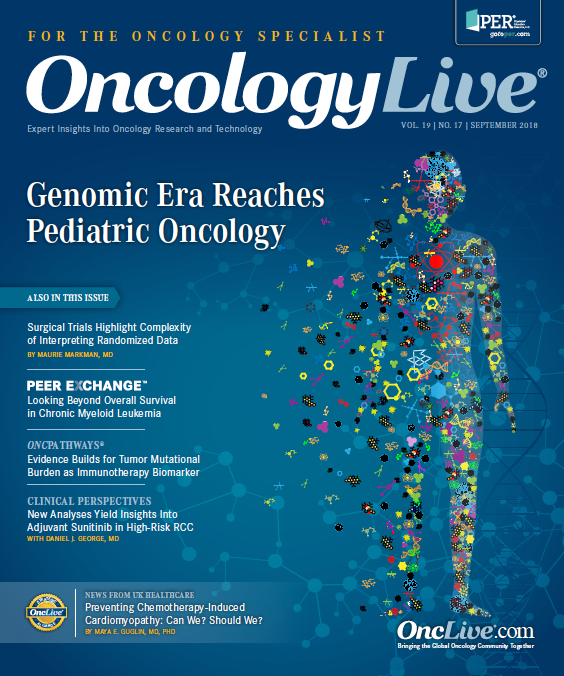Publication
Article
Oncology Live®
Surgical Trials Highlight Complexity of Interpreting Randomized Data
Author(s):
In recent years there has been much discussion about the serious limitations of the conduct and interpretation of randomized trials examining the utility of antineoplastic drug therapy.
Maurie Markman, MD

Maurie Markman, MD
In recent years there has been much discussion about the serious limitations of the conduct and interpretation of randomized trials examining the utility of antineoplastic drug therapy. Concerns include the intentional or unintentional exclusion of elderly patient populations and individuals with common and clinically relevant comorbidities (eg, current or past history of cardiac illness). Although the desire is to create the most homogeneous study population possible in order to isolate the clinical utility of an investigative strategy, the unfortunate end result is often that a very large percentage of real-world patients with cancer is excluded, casting doubt upon the overall relevance of the trial outcome.
It is important to acknowledge that the applicability of randomized trial results in oncology is not an issue that is limited to antineoplastic drug therapy. For example, efforts to ensure homogeneity of clinical characteristics to isolate the impact of a surgical intervention will also raise the question of whether an individual encountered in routine clinical practice will experience benefit that is similar to a trial-suggested outcome. There may be significant differences. That patient may be older than a significant majority of the study participants and have 1 or several comorbid conditions that were present in only a small proportion, if any, of the trial cohorts.
Further, as is also the case with drug trials, randomized surgical studies examine the impact of an intervention on a population of patients, with the basic assumption that all research subjects have an equal likelihood of experiencing clinical benefit or harm. Therefore, the potential utility of the strategy in a small subgroup of the participants may be missed.
In a recently reported international randomized study of 2509 patients with stage II or III colorectal cancer, investigators examined the impact on mortality of a more- or less-frequent testing schedule following curative surgery.1 Patients were tested with serum carcinoembryonic antigen monitoring and computed tomography (CT) scans of the thorax and abdomen at 6, 12, 18, 24, and 36 months versus only 12 and 36 months after surgery.
It was not surprising was that there was no significant reduction in 5-year overall mortality or colorectal cancer-specific mortality. But this study is unlikely to answer the question of whether more- or less-frequent monitoring is appropriate for unique patient subgroups whose biology may be different from the more general population.
How would the frequency of monitoring impact survival, for example, of a patient who develops an isolated 1-cm metastatic lesion in the liver (confirmed on CT scan) approximately 18 months after surgery? In this specific setting, would waiting an additional 18 months to find the abnormality affect the potential for a surgical cure?
Despite a desire and concerted effort to assemble patient groups as homogeneous as possible through the randomization process to ensure the critical examination of efficacy and toxicity endpoints, it is difficult to know if this goal has been achieved.
However, in striking contrast to antineoplastic drug trials, where one can reasonably assume that what one is observing are the biological and clinical effects of a drug (or drugs) delivered at a protocol-specified dose and schedule, with surgical trials the outcome (both efficacy and adverse events) will likely be critically influenced by the skills and experience of the individual surgeon and the institution where the procedure is performed.
There is no better example of this than the continuing controversy surrounding surgical intervention in advanced ovarian cancer. Since the landmark small nonrandomized single-surgeon study by C. Thomas Griffiths, MD, in the early 1970s, which described the success of primary cytoreductive surgery in relation to residual tumor mass, there has been an intense and unresolved debate regarding the benefits versus risks of this approach and the extent to which aggressive efforts to eliminate any gross residual disease should be undertaken prior to the administration of platinum-based cytotoxic chemotherapy.2
Remarkable—but perhaps not surprising—to date there has been no reported phase III trial directly examining the survival outcome of primary surgery followed by chemotherapy versus primary chemotherapy alone (with surgery reserved to deal with complications of the malignancy—eg, bowel obstruction).2 However, the question of neoadjuvant chemotherapy followed by surgery versus primary surgery followed by chemotherapy has been addressed in several phase III studies with the results demonstrating equivalent survival outcomes but less treatment-related morbidity associated with the neoadjuvant approach.2
The point is that many well-established gynecologic oncologists strongly support the clinical utility of the primary surgical approach and have nonrandomized peer-reviewed published experiences with primary cytoreductive surgery that suggest an overall superior outcome compared with published results of randomized neoadjuvant trial patient populations. These reports imply that the experience individual surgeons and institutions have with handling highly complex surgical procedures and complications, both in the intraoperative and postoperative settings, may substantially impact outcomes that are not captured within the confines of study populations.
So, which is better—the published data in so-called gold standard randomized trials employing a trial design to ensure homogeneity and including the combined experience of a large group of gynecologic surgeons, or the reported nonrandomized but often extensive experience of a select group of such surgeons and institutions?
One might reasonably suggest this particular question and many such surgical issues will never be adequately answered through the conduct of phase III randomized trials, no matter how well such studies are designed.
References
- Wille-Jorgensen P, Syk I, Smedh K; for the COLOFOL Study Group, et al. Effect of more vs less frequent follow-up testing on overall and colorectal cancer-specific mortality in patients with stage II or III colorectal cancer. JAMA. 2018;319(20):2095-2103. doi: 10.1001/jama.2018.5623.
- Schorge JO, Bregar AJ, Durfee J, Berkowitz RS. Meigs to modern times: the evolution of debulking surgery in advanced ovarian cancer. Gynecol Oncol. 2018;149(3):447-454. doi: 10.1016/j.ygyno.2018.03.001.



























%20(2)%201-Recovered-Recovered-Recovered-Recovered-Recovered-Recovered-Recovered-Recovered-Recovered-Recovered-Recovered-Recovered-Recovered-Recovered-Recovered-Recovered-Recovered.jpg?fit=crop&auto=format)
%20(2)%201-Recovered-Recovered-Recovered-Recovered-Recovered-Recovered-Recovered-Recovered-Recovered-Recovered-Recovered-Recovered-Recovered-Recovered-Recovered-Recovered-Recovered.jpg?fit=crop&auto=format)
